Reading Time: 34 Minutes
Influencer recruiting is the key to running successful influencer campaigns.
You want to be sure that the influencers you invest in are true brand storytellers and share not only the same audience but also the same values as your brand.
How to find influencers that will benefit a specific type of campaign still remains a major roadblock for many brands. According to a study by the National Association of Advertisers, 60% of marketers say that identifying the right influencers is their biggest challenge.
“80% of consumers complete a purchase after seeing an influencer recommend that product on social media.”
– GRIN, 101 Vitally Important Influencer Marketing Statistics
The creators you partner with should align with your brand’s core values. Every brand is different, which is why no one influencer outreach strategy is the same.
Influencers are successful when they connect with members of their audience. It’s the connection that results in authenticity. By pinpointing these creators, your brand can achieve that same level of authenticity and connectedness with the influencers’ followers.
When consumers trust product endorsements from their favorite creators, they are more likely to express interest, visit your website, and convert. The right influencer partnerships help you nurture genuine connections with members of your target audience.
“The number one reason why followers don’t trust an influencer occurs when that influencer promotes products that they don’t genuinely care about.”
– GRIN, 101 Vitally Important Influencer Marketing Statistics
The influencer “halo effect” cuts both ways. It’s true that consumers who trust a particular influencer will more than likely trust you when that influencer recommends your brand. Conversely, consumers who distrust an influencer’s authenticity will pass that distrust onto you when that influencer promotes your product/service.
Consumers don’t mind it when creators promote brands through sponsored posts. But an inauthentic brand mention is a different story. A bad brand-influencer match can cause audiences to feel suspicious.
Partnering with the wrong influencers can lower campaign results or render it ineffective altogether. At worst, it may even harm your brand’s reputation.
When looking for influencers, it’s a good idea to understand things:
Answering the following questions will show you which influencers you should target for your brand.
Many influencers operate as pseudo celebrities within a particular lifestyle or virtual community. You can pinpoint a creator’s influence by how large their engaged audience is.
First looking at follower count, then post impressions, and next engagements.
See Also: Influencer Engagement Rate Calculator
It can be tempting to onboard a creator just because you love their content and personality. But the influencers you recruit need to be a good match for your brand.
It shouldn’t be a stretch for your influencers to promote your products within their non-sponsored, daily posts. Without this industry and interest alignment, that creator’s endorsements runs the risk of coming off as inauthentic to their audience.
Be careful about assuming that high engagement means that all or most of those engagements are genuine. You can audit a creator’s profile by pulling out a handful of their recent posts, and reading the comments.
Quality follower engagements are specific, thoughtful, and relevant to the creator’s original post. Additionally, top-performing influencers are diligent to engage follower comments whether or not they are promoting a brand.
Identifying influencers with the “right vibe” will take some time. But once you pinpoint the right influencer relationships, you can more easily find other creators who are also compatible with your brand.
For example, your best creator matches might have certain personality traits that fit your brand perfectly. They may also use specific words, phrases, and styles within their posts.
When you identify these attributes, look for other creators that match your ideal creator profile.
It can sometimes be difficult to know how easy a creator is to work with until you collaborate with them on a campaign. Just because a creator checks all your boxes doesn’t mean that they are reliable.
Identifying which influencers are easy to work with will save you time and money as you scale your influencer program.
See Also: 5 Characteristics of a Good Influencer
Searching for creator partnerships for the first time can feel daunting. But with the right approach, influencer recruiting is quite simple.
Knowing who your customers are is critical, because many of your recurring customers are also influential on social media. These creator partnerships often work very well because you already know that they love your products and understand how they work.
After confirming their online presence and credibility, consider using these creators in a few campaigns to test compatibility with your brand.
As you expand your search to influencers with larger followings, remember that every influencer you work with should represent a segment of your audience. It’s a good idea to use your buyer personas as a guide to discovering new creators to promote your brand.
It’s also important to know where your ideal customers make social media connections and engage creators and brands.
If you have a large budget and team, you may be able to leverage all major social channels well with the help of influencers. But if you’re like most brands, you’re going to achieve better results by mastering 2-3 social channels at first.
Once you’ve established yourself on those channels, your influencer team can help you expand to other social media platforms.
Here is a look at some of the most popular social media networks worldwide as of January 2024 ranked by number of active users:
As you begin reaching out to influencers on the social channels you’ve selected, consider using some of our outreach templates here.
To achieve maximum campaign returns, you should clearly state what you hope to gain with the help of influencers. Your goals – whether sales, brand awareness, website traffic, etc. – dictate which creator strengths matter most to your recruiting process.
For example, a goal to increase sales is most relevant to those influencers with smaller followings and high engagement rates. These passionate audiences are often more inclined to take action when their favorite influencer endorses a product.
Similarly, creators with a wider reach are great for creating online chatter for your brand.
When setting your influencer goals and key performance indicators (KPIs), consider which stage(s) of the marketing funnel you’re hoping to address. This approach helps you refine your influencer recruiting process.
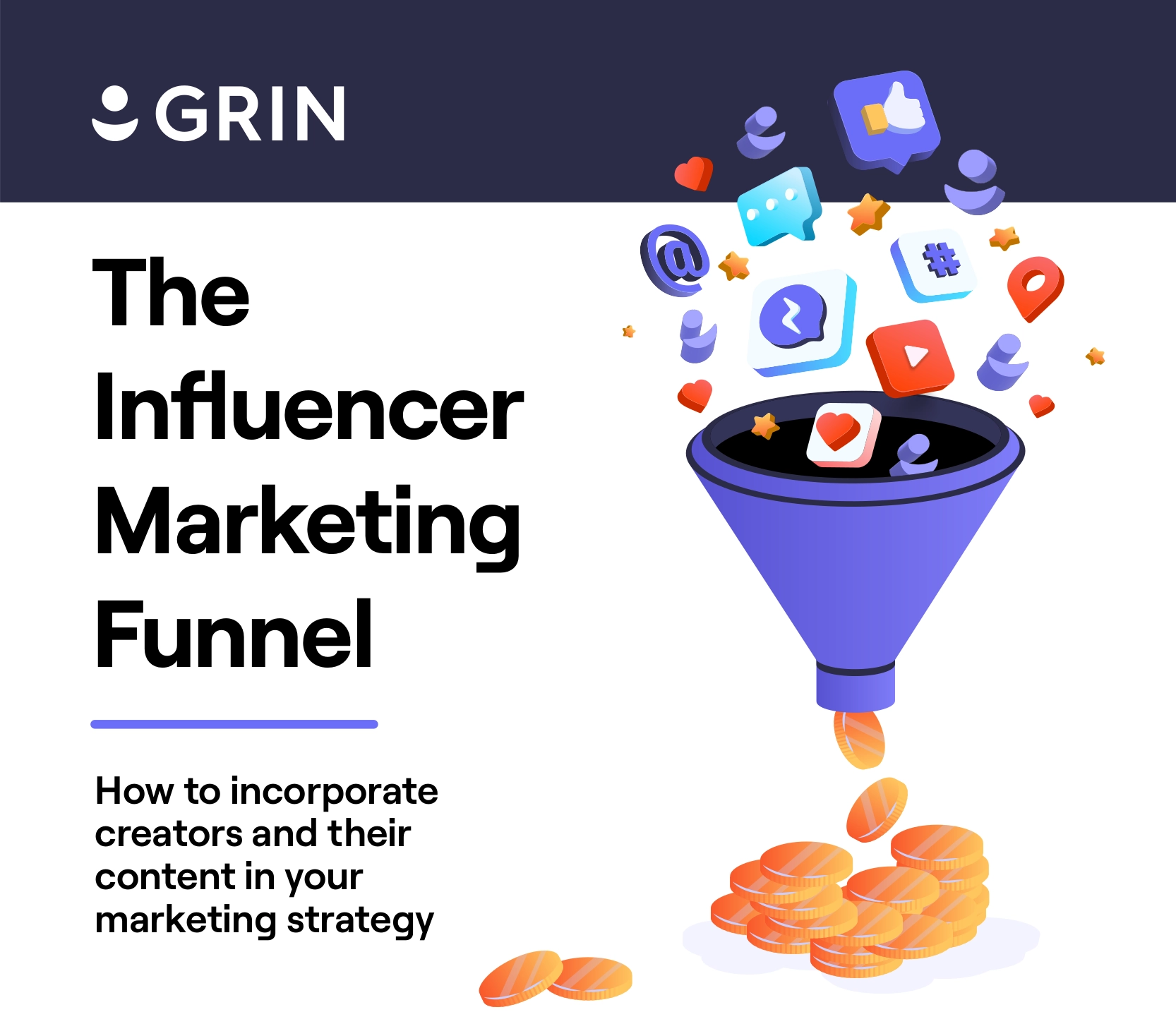
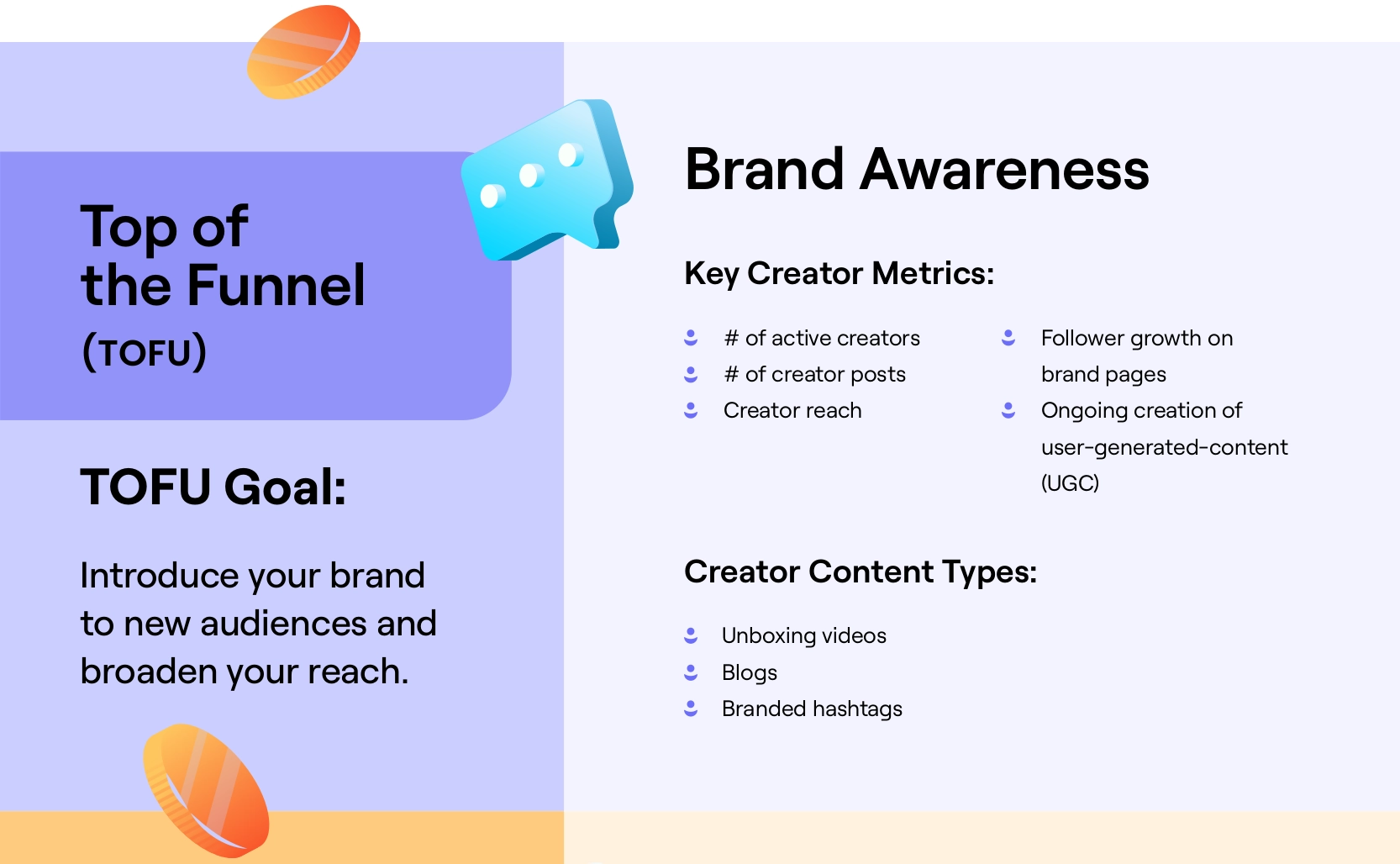
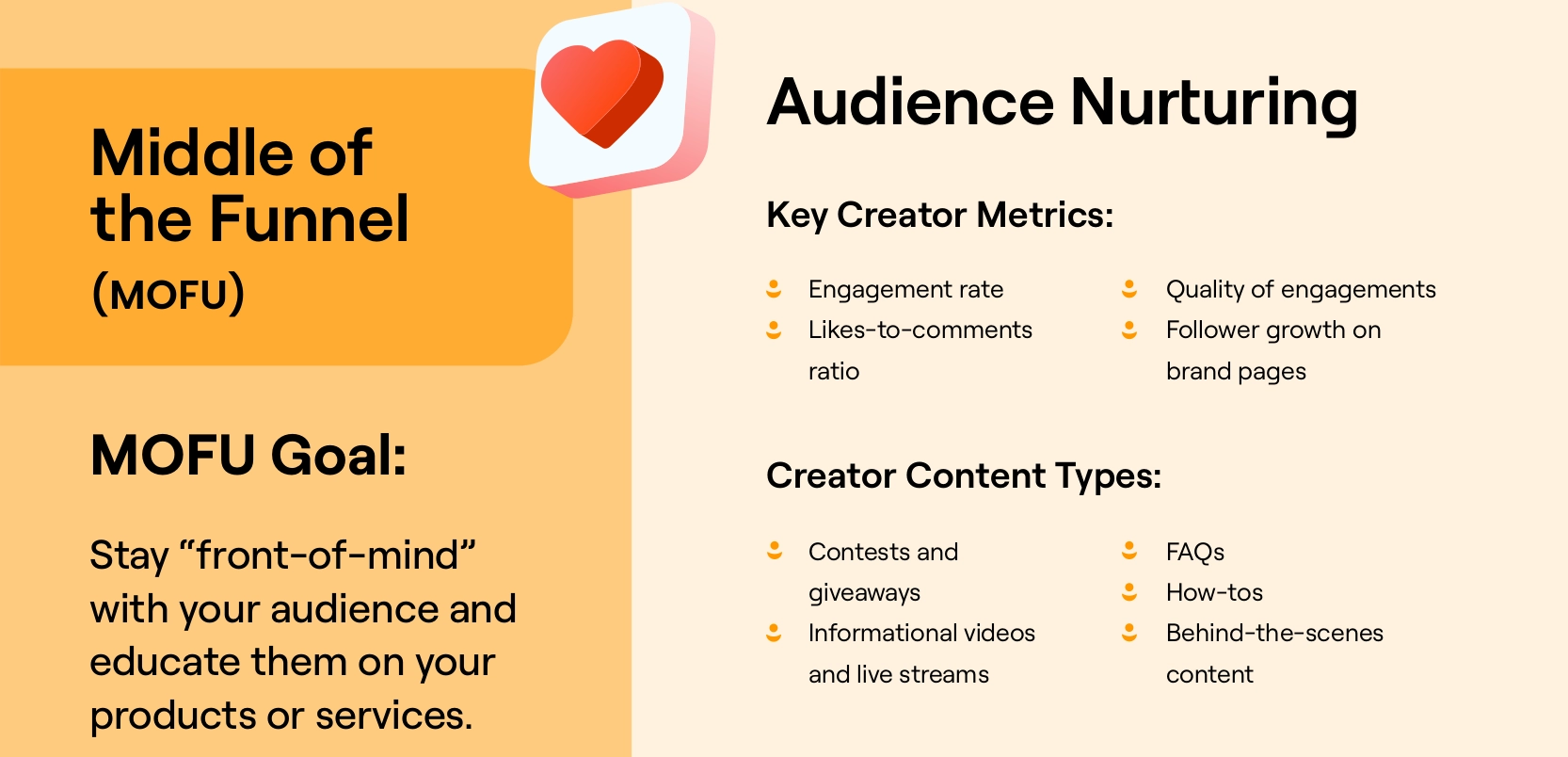
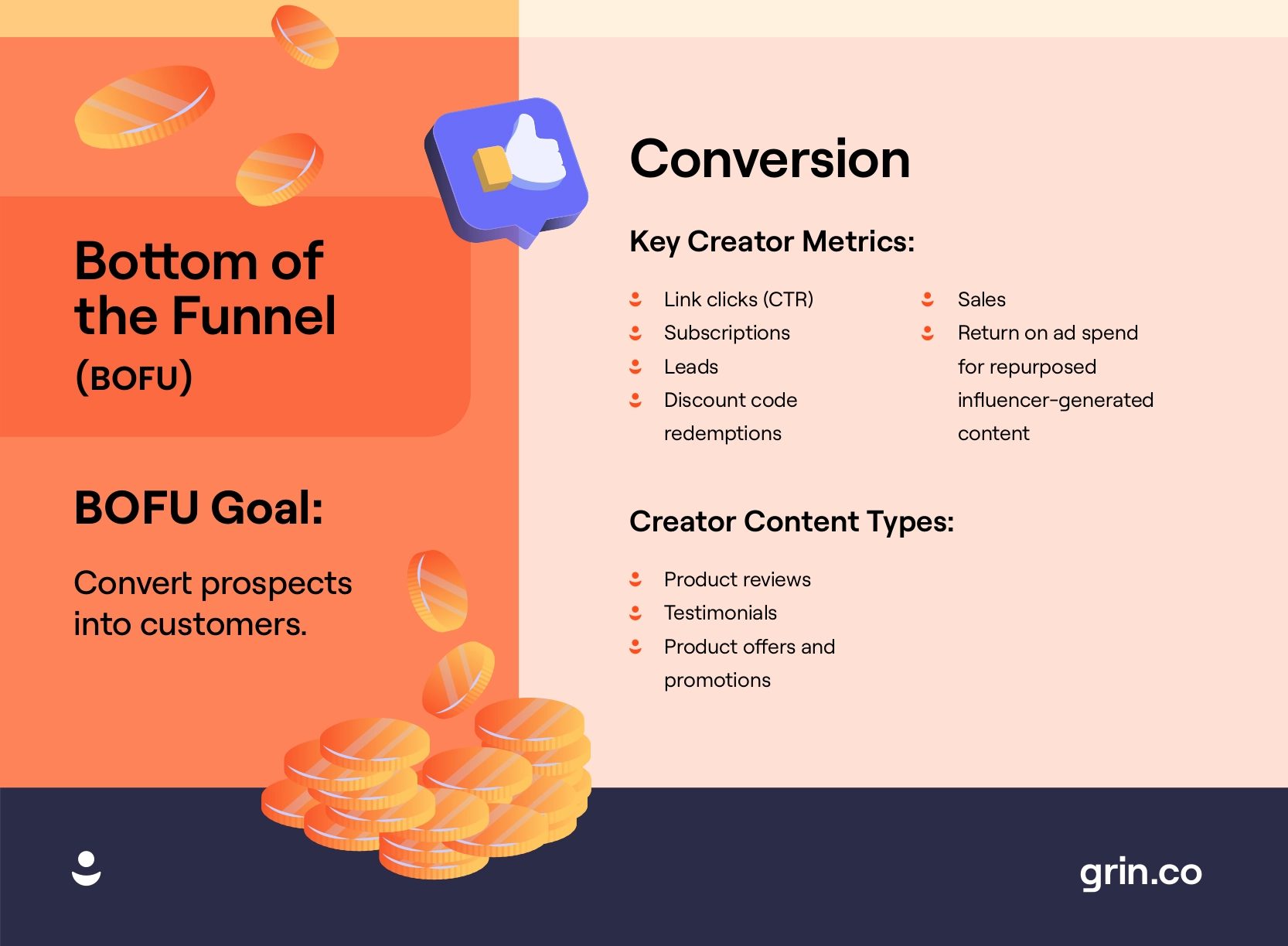
Your influencer KPIs show you which campaign metrics are most critical to your campaign success.
For example, if you have the following KPI…
To obtain 1,000 UGC posts, comments, and shares by [deadline]
…then you can be selective about your influencer prospecting by noting those creators who achieve great conversations within the comments section of their posts. Similarly, you can find creators who are great at generating participation for events, contests, surveys, challenges, and more.
As an established brand, you have much more information to work with. You have a larger customer base, and you may already have thousands of followers on social media.
It’s likely that as an established brand, you’ve already launched a few influencer campaigns. The first thing you should do is examine your past partnerships and determine what worked and what didn’t work about those campaigns.
Take a closer look at the creators you worked with. Note which creators achieved results (i.e. content, brand awareness, revenue, etc) and what made them a great fit.
Finding the right influencers doesn’t have to mean prospecting from scratch. Once you’ve found a handful of influencers that fit your brand, you can look for other creators that are similar.
This approach is called searching for influencer lookalikes. If you don’t already have a process for identifying lookalike influencers, consider using our free GRIN tool here.
If you want to test different types of creators, social media channels, and content, much of the information you pulled from your influencer audit will guide you as you expand your search.
It’s often best to determine which platforms you want to be on. From there, you can reach out among your current influencers to see which ones are already operating on that platform.
Make sure that you’ve clearly defined your target audience, along with different niche audiences. Any creator you choose should authentically represent one or more niche audiences.
You can also ask your influencers for ideas to try new things. Thinking outside the box is an influencer’s “bread and butter,” and brands that regularly brainstorm with their top creator partners often launch the most impressive campaigns.
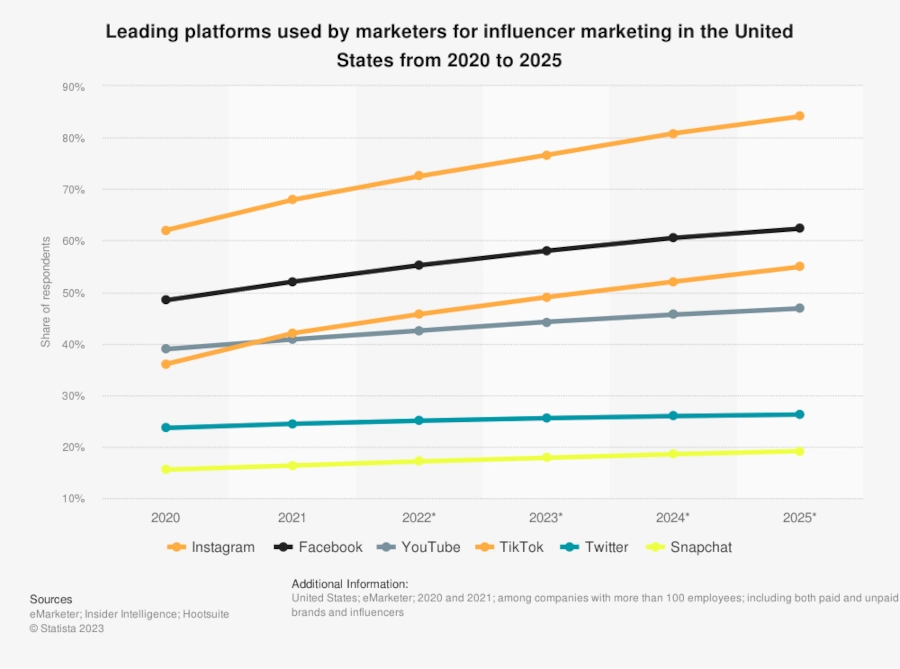
Image via Statista
Instagram is the most popular platform for creators. If you’re unsure about where to begin your influencer search, you can start here.
While Instagram favors Millennial audiences and younger, many brands partner effectively with creators who reach nearly every demographic. That’s why Instagram is so popular and a great place to launch a new influencer program.
When you find an influencer you like, take the following steps:
Facebook offers the widest audience of any other social media channel. If you’re interested in reaching older audiences, such as older Millennials and Boomers, this is a great place to start.
One of the best Facebook features is its robust groups. It’s a good idea to scout any groups relevant to your industry, join, and follow the conversations. Many Facebook influencers lead a group or are active in multiple groups.
Here are steps you can take to recruit Facebook influencers:
All of the best video creators are on YouTube. Many are accomplished videographers with the ability to shoot and edit their videos with as much expertise as any creative agency.
YouTubers also enjoy some of the most engaged audiences of any other platform. Landing a good creator match on YouTube can produce enormous results for your brand.
When you find a YouTuber you like, do the following:
TikTok is the leading platform for Millennials and Gen Z-ers. It is also the fastest growing platform in the history of social media.
Because TikTok offers many great video shooting and editing options, most creators aren’t professionals. This in-real-life (IRL) appeal connects well with younger audiences.
To recruit influencer prospects, consider the following steps:
Twitter/X is a hotbed for key opinion leaders and B2B experts. It also reaches older audiences, similar to Facebook.
If your brand works well with memes and short, written posts, Twitter is a great place to search for influencers. It’s also a great platform for sharing links and big announcements.
Here’s how you can reach out to Twitter/X creators:
See Also: The Platform Formerly Known as Twitter: A Complete Guide to Twitter Influencer Marketing on X
LinkedIn is the best place for B2B influencer marketers to recruit industry experts, thought leaders, and business partners.
Here’s how you can reach out to professionals on LinkedIn:
Twitch is the go-to platform for long-form video live-streamers. It’s most popular among gamers, but also attracts musicians, artists, chefs, movie critics, and more.
Here’s how to reach out to your favorite streamer:
Pinterest is one of the ultimate discovery platforms. So why not discover your next best creator there, too?
Here’s how to get started:
Looking for creators on Snapchat can be a great way to tap into a younger, highly engaged audience. These users generally understand the latest social media technology and weave it into their content creatively.
Start like this:
See Also: Snapchat Influencer Marketing
Discord creators can help connect you with passionate communities that share common interests, from gaming to music to art. Collaborate with influential members of these communities who can help spread the word about your brand or product.
Here’s how to begin your search:
Your first step for finding the right influencer is to separate authentic from inauthentic creators.
For example, fake influencers will try to buy followers and engagements to give the appearance of popularity and authority. Others may join influencer pods and participate in quid-pro-quo arrangements with other aspiring influencers.
To identify authentic, high-performing creators, you can examine the following basic data points:
The basic way to understand a creator’s reach is to look at their follower count. Most influencer programs focus on recruiting creators with 1,000 or more followers on at least one social media platform.
On some platforms, you can also identify reach by post or video views. Creators with smaller followings can (and often do) expand their reach by using tags and hashtags effectively.
When creators nurture large audiences as followers, you can dig further to find out how engaged those followers are with that influencer.
Any post reaction/like, comment, or share counts as an engagement. You can calculate a creator’s engagement rate by dividing the number of engagements by the number of followers:
# of engagements / # of followers = engagement rate
Because likes are a vanity metric (it takes very little effort for a fan to click the “like” button), many marketers prefer to focus on post comments and shares. Creators that cultivate strong relationships with their followers enjoy robust discussions within their comments, as well as a large amount of content sharing.
By taking a closer look at post comments, you’ll recognize creator-follower connections when you see them. Influencers that only elicit short or shallow engagements may not be coming by their engagements honestly.
Many of the issues raised above – unengaged audiences, post comments lacking substance, etc. – can help you weed out fake influencers. But there are additional things you can track to help you know how credible a creator is within their industry.
For creators that brand themselves as experts, it’s always a good idea to check for relevant credentials. Doing so keeps you from accidentally partnering with an influencer that gives out bad advice.
You can also take a closer look at an influencer’s followers. Do any followers also have a wide reach? Are post engagements primarily coming from followers or non-followers? Do any follower profiles look fake or fraudulent?
You can also examine a creator’s ratio of followers to followees (profiles that a creator follows). In 2019, a research team in the International Journal of Innovation in Management published a study demonstrating that audiences felt more at ease with creators who had a follower count that was higher than their followee count.
This trust made it easy for those followers to take that influencer’s product endorsements seriously. Conversely, creators who followed more people than followed them had a more difficult time getting their fans to take action on sponsored posts.
The more practice you have building your influencer team, the easier it will be for you to accurately identify a creator’s credibility.
It is difficult to maintain relationships with an audience when a creator fails to produce. A high follower count with low content volume is unlikely to help your brand gain momentum on that social platform.
When a creator posts consistently over an extended period of time, you can feel confident that that influencer is in tune with the needs of their audience and takes their role seriously.
When examining a creator’s content, review how often they endorse products. Top-performing influencers typically post more non-sponsored than sponsored content. Also, they tend to be picky about the brands they partner with.
Social network analysis is the process of identifying who your current creator partners are connected to. Many of your influencers are friends, acquaintances, and partners with other individuals who are a great match for your brand.
Similar to in-person business networking, social network analysis can help you connect with key individuals in your industry, expand your reach, and build stronger connections with those influencers’ fans.
When you’re just launching your influencer program, you can easily manage your recruiting and creator relationships within a spreadsheet.
As you onboard your creators, record as many performance metrics as you can to pinpoint success when you see it. Doing so will help you identify your top performers and find lookalike influencers.
To scale your program without burning yourself out, you should consider adding an influencer management platform to your marketing tech stack.
With the right influencer software, you’ll be able to dramatically increase your productivity and find your ideal influencers more easily.
Advancing technology has made it possible for creator management software to combine every tool you need to manage all partnerships in a single platform.
A good influencer marketing software keeps you organized. There is no need to transfer information from multiple platforms or social media pages into spreadsheets. This one-stop-shop approach lets you create a list of potential influencers and remove some from the list as you go.
Choosing the right influencer management software means finding a tool that will provide:
Find out how much time you can save with influencer marketing software: GRIN’s Time Saving Calculator
As you build an influencer community, the most important thing is nurturing long-term relationships with your best creators. When you find that perfect creator relationship, you can identify key attributes about that influencer to help you find more just like them.
It’s also important to note that data-driven creator recruiting requires you to examine quantitative and qualitative data. It’s not just important to know “how many,” you need to look beyond the numbers to find out what makes your brand-creator relationships truly special.
Before long, identifying new influencers for your brand will become second nature. Adding the right recruiting tools to your creator management process will further streamline influencer searching, vetting, and onboarding. More importantly, the quality of your creator relationships will spread to other creators and produce a steady stream of new people who also want to promote your brand.
Learn more about influencer marketing: Influencer Marketing 101
Our team keeps a finger on the pulse, so you’re always working with the latest information.